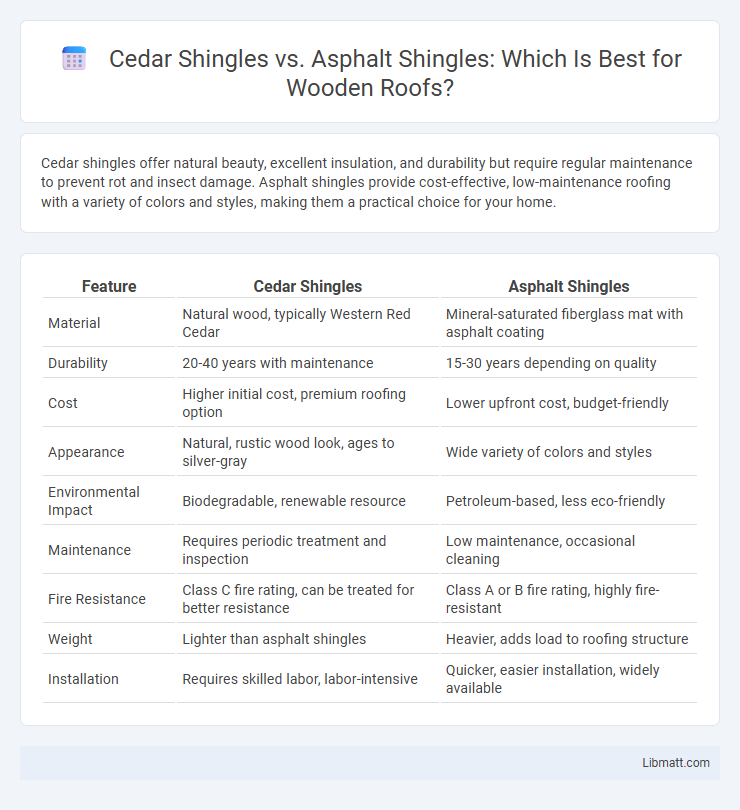Cedar shingles offer natural beauty, excellent insulation, and durability but require regular maintenance to prevent rot and insect damage. Asphalt shingles provide cost-effective, low-maintenance roofing with a variety of colors and styles, making them a practical choice for your home.
Table of Comparison
| Feature | Cedar Shingles | Asphalt Shingles |
|---|---|---|
| Material | Natural wood, typically Western Red Cedar | Mineral-saturated fiberglass mat with asphalt coating |
| Durability | 20-40 years with maintenance | 15-30 years depending on quality |
| Cost | Higher initial cost, premium roofing option | Lower upfront cost, budget-friendly |
| Appearance | Natural, rustic wood look, ages to silver-gray | Wide variety of colors and styles |
| Environmental Impact | Biodegradable, renewable resource | Petroleum-based, less eco-friendly |
| Maintenance | Requires periodic treatment and inspection | Low maintenance, occasional cleaning |
| Fire Resistance | Class C fire rating, can be treated for better resistance | Class A or B fire rating, highly fire-resistant |
| Weight | Lighter than asphalt shingles | Heavier, adds load to roofing structure |
| Installation | Requires skilled labor, labor-intensive | Quicker, easier installation, widely available |
Introduction to Cedar Shingles vs Asphalt Shingles
Cedar shingles offer a natural, rustic aesthetic with excellent insulation properties and durability, making them a popular choice for homeowners seeking eco-friendly roofing options. Asphalt shingles provide cost-effective installation and maintenance, widespread availability, and a variety of styles and colors suitable for diverse architectural designs. Understanding the differences in lifespan, environmental impact, and overall performance can help you make an informed decision for your roofing project.
Material Composition and Differences
Cedar shingles are crafted from natural wood, primarily Western Red Cedar, offering a biodegradable option with excellent insulation and a distinctive rustic appearance. Asphalt shingles consist of a fiberglass or organic base mat coated with asphalt and mineral granules, providing durability, fire resistance, and a range of color options. The fundamental difference lies in material origin: cedar shingles offer natural aesthetics and breathability, while asphalt shingles deliver enhanced weather resistance and lower upfront costs.
Durability and Longevity Comparison
Cedar shingles offer natural resistance to rot, insects, and weathering, often lasting 30 to 40 years with proper maintenance, outperforming many asphalt shingles which typically have a lifespan of 20 to 30 years. The density and natural oils in cedar contribute to its durability, making it a preferred choice in regions prone to extreme weather conditions. Asphalt shingles, while cost-effective and easier to install, may require more frequent replacement and are more susceptible to damage from UV exposure and temperature fluctuations.
Aesthetic Appeal and Visual Impact
Cedar shingles offer a natural, rustic aesthetic with unique grain patterns and warm, earthy tones that enhance curb appeal and blend seamlessly with natural surroundings. Asphalt shingles provide a more uniform, versatile look available in a wide range of colors and styles, allowing for greater customization to match various architectural designs. The choice between cedar and asphalt shingles significantly affects the overall visual impact of a roof, influencing both style and character of a home.
Weather Resistance and Performance
Cedar shingles offer superior weather resistance due to their natural oils, which make them resistant to moisture, wind, and temperature fluctuations, providing long-lasting durability in harsh climates. Asphalt shingles excel in performance with excellent water resistance and quick installation, making them a cost-effective choice for moderate weather conditions. Your decision should consider cedar's natural resilience for longevity or asphalt's reliable protection combined with ease of maintenance.
Installation Process and Complexity
Cedar shingles require precise installation with careful nailing and spacing to allow for natural expansion and moisture drainage, often demanding skilled craftsmanship and more time compared to asphalt shingles. Asphalt shingles offer a simpler, faster installation process with uniform sizes and self-sealing strips, making them more accessible for DIY projects and standard roofing professionals. The complexity of cedar installation increases labor costs, while asphalt shingles provide a cost-effective and straightforward alternative.
Maintenance Requirements
Cedar shingles require regular maintenance, including annual cleaning and periodic sealing or staining to prevent rot, insect damage, and weathering. Asphalt shingles have lower maintenance needs, typically only requiring occasional inspections and minor repairs to ensure longevity of 20-30 years. Proper upkeep of cedar shingles extends their lifespan significantly, while asphalt shingles offer a more hassle-free, maintenance-light roofing option.
Environmental Impact and Sustainability
Cedar shingles are a renewable resource made from natural wood, offering biodegradability and better insulation qualities, which reduce energy consumption. Asphalt shingles, while more affordable, rely on petroleum-based products, contributing to higher carbon emissions and landfill waste due to their limited recyclability. Choosing cedar shingles supports your commitment to sustainable roofing by minimizing environmental impact and promoting eco-friendly materials.
Cost Analysis and Value for Money
Cedar shingles generally cost between $4 to $7 per square foot, significantly higher than asphalt shingles, which typically range from $1 to $4 per square foot. Despite the higher initial investment, cedar shingles offer superior durability, natural insulation, and a lifespan of 30 to 50 years, compared to asphalt shingles' 15 to 25 years, providing better long-term value. Homeowners seeking aesthetic appeal and natural materials may find cedar shingles justify the cost, while budget-conscious projects often favor the affordability and ease of installation of asphalt shingles.
Choosing the Right Shingle for Your Home
Cedar shingles offer natural insulation, durability, and a unique aesthetic that enhances curb appeal, while asphalt shingles provide cost-effective installation, easy maintenance, and a wide range of color options. Your choice depends on factors like budget, climate resilience, and the architectural style of your home, with cedar ideal for longevity and natural beauty, and asphalt suited for affordability and versatility. Understanding these differences ensures you select the right shingle that balances durability, cost, and appearance for your specific roofing needs.
Cedar shingles vs asphalt shingles Infographic

 libmatt.com
libmatt.com